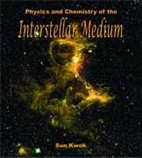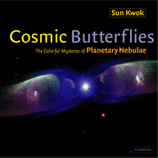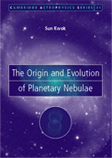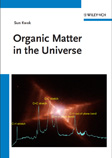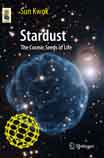Sun Kwok's Research Areas
Advanced stages of stellar evolution,stellar winds, planetary nebulae, interstellar chemistry, infrared spectroscopy
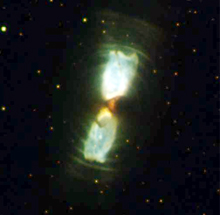
Prof. Kwok's main research interest has been the effects of mass loss on the late stages of stellar evolution. He has proposed that radiation pressure on grains is the mechanism of mass loss in asymptotic giant branch (AGB) stars (Kwok 1975, ApJ, 198, 583) and showed that OH maser emission from AGB stars is a manifestation of mass loss (Kwok 1976 JRASC, 70, 49). Through infrared and millimetre-wave spectroscopic observations, he found that the mass loss rates of AGB stars are so high that they should have significant effects on AGB evolution (Kwok 1987, Physics Reports,156,3). He also promoted the idea that the AGB is terminated by the complete removal of the hydrogen envelope through mass loss before carbon can be ignited. The exposure of the core and the subsequent initiation of another fast wind lead to a "snow-plow" effect that creates a planetary nebula (Kwok, Purton, & FitzGerald 1978, ApJ, 219, L125). This "interacting-winds" theory has become the standard model of planetary nebulae formation and has led to a new understanding of the dynamical evolution of planetary nebulae, as well as the origin of their different morphologies (Kwok 1994, PASP,106, 344).
After the IRAS mission, Kwok and Bruce Hrivnak began to search for "proto-planetary nebulae (PPN)", the missing link between the AGB and planetary nebula phases, using infrared colors as criteria. Over 30 candidates of PPN were discovered (Kwok 1993, Ann. Rev. Astron. Astrophys. 31, 63; Kwok, 2001, Encyclopedia of Astronomy & Astrophysics, p. 2168). Follow-up observations by the HST have shown that many of these PPNs have bipolar morphology (see the Cotton Candy Nebula in the figure above), suggesting that the shaping of PNs occurs soon after the AGB.
The importance of PPNs goes beyond the shaping of PNs. Active chemical synthesis is ongoing in the circumstellar envelopes of PPNs. The unidentified 21 mircon emission feature,believed to originate from an carbonaceous compound, is discovered in PPNs (Kwok, Volk, & Hrivnak, 1989, ApJ, 345, L51, see also report in Science). ISO observations of PPNs have shown that complex organic molecules are being synthesized, including aromatic compounds with aliphatic side groups (Kwok, Volk, & Hrivnak, 1999, Astr. Ap., 350, L35; Kwok, Volk, & Bernath, 2001, ApJ, 554, L87). We now recognize that the circumstellar synthesis of inorganic and organic matter plays an important role in the chemical enrichment of the Galaxy and the early solar system (Kwok 2004, Nature, 430, 985; Kwok 2009, APSS, 319, 5 ).
Soon after the initial discovery of fullerene (C60) in space by Cami et al. (2000, Science, 329, 1180), Prof. Kwok reported the first discovery of C60 in proto-planetary nebulae (Zhang & Kwok 2011, ApJ, 730, 126). This discovery put severe constraints on the formation mechanism of C60 and provided a useful indicator for its chemical precursor.
Recently, he promoted the idea that well-known unidentified infrared emission bands are due to carbonaceous nanoparticles of mixed aromatic-aliphatic structure (Kwok & Zhang 2011, Nature, 479, 80; Kwok & Zhang 2013, ApJ, 771, 5). The fact that complex organic compounds are widely present in the Universe (Kwok 2011, Organic Matter in the Universe, Wiley; Kwok 2016, Rev. Astron. Astrophys., 24, 8). has led to our realization that abiotic synthesis of complex organics is common and highly efficient Kwok 2017, Nature Astronomy, 1, 642). The delivery of stellar synthesized organics to the primordial solar system may have implications on the origin of life (Kwok 2009, Inter. J. Astrobiology, 8, 161).

